Themed collection Biosensors

Introduction to Biosensors
Shaoqin Liu and Ning Gu, Journal of Materials Chemistry B themed issue on Biosensors.

J. Mater. Chem. B, 2020,8, 3168-3170
https://doi.org/10.1039/D0TB90051F
Assessing the range of enzymatic and oxidative tunability for biosensor design
This review aims to inspire novel biosensor design by addressing materials chemistries through the lense of enzymatic and oxidative susceptibility in the spectra of inflammatory disease biomarkers.
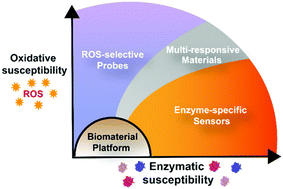
J. Mater. Chem. B, 2020,8, 3460-3487
https://doi.org/10.1039/C9TB02666E
Enhanced biosensing strategies using electrogenerated chemiluminescence: recent progress and future prospects
An overview of enhancement strategies for highly sensitive ECL-based sensing of bioanalytes enabling early detection of cancer.
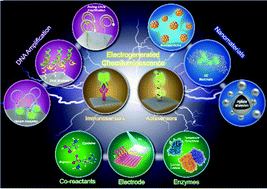
J. Mater. Chem. B, 2020,8, 3192-3212
https://doi.org/10.1039/C9TB02578B
Nanomaterial-based biosensors for DNA methyltransferase assay
We review the recent advances in the development of nanomaterial-based biosensors for DNA methyltransferase assay.
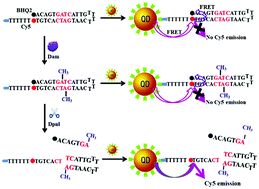
J. Mater. Chem. B, 2020,8, 3488-3501
https://doi.org/10.1039/C9TB02458A
Stretchable and tough conductive hydrogels for flexible pressure and strain sensors
This review summarises recent advances in stretchable and tough conductive hydrogel sensors for wearable and implantable devices.
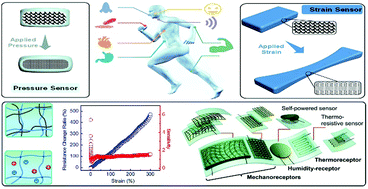
J. Mater. Chem. B, 2020,8, 3437-3459
https://doi.org/10.1039/C9TB02570G
Nanomaterial-based gas sensors used for breath diagnosis
Gas-sensing applications commonly use nanomaterials (NMs) because of their unique physicochemical properties, including a high surface-to-volume ratio, enormous number of active sites, controllable morphology, and potential for miniaturisation.
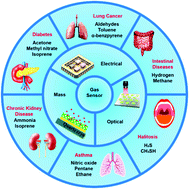
J. Mater. Chem. B, 2020,8, 3231-3248
https://doi.org/10.1039/C9TB02518A
Aptamer-based nanostructured interfaces for the detection and release of circulating tumor cells
This paper summarizes various aptamer-functionalized nanostructured interfaces for the detection and release of circulating tumor cells.
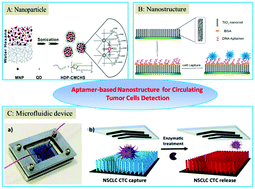
J. Mater. Chem. B, 2020,8, 3408-3422
https://doi.org/10.1039/C9TB02457C
Wearable biochemical sensors for human health monitoring: sensing materials and manufacturing technologies
Recent achievements and challenges in materials and manufacturing technologies of sensing electrodes in wearable biosensors have been highlighted.
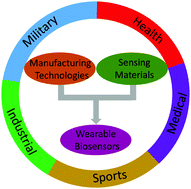
J. Mater. Chem. B, 2020,8, 3423-3436
https://doi.org/10.1039/C9TB02474C
Genetically encoded light-up RNA aptamers and their applications for imaging and biosensing
Light-up RNA aptamers and their applications in bioimaging and biosensing of small ligands and biomacromolecules are described.
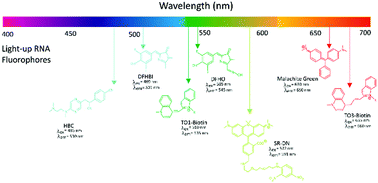
J. Mater. Chem. B, 2020,8, 3382-3392
https://doi.org/10.1039/C9TB02668A
From design to applications of stimuli-responsive hydrogel strain sensors
Stimuli-responsive hydrogel strain sensors that synergize the advantages of both hydrogel and smart functional materials have attracted increasing interest from material design to emerging applications in health monitors and human–machine interfaces.

J. Mater. Chem. B, 2020,8, 3171-3191
https://doi.org/10.1039/C9TB02692D
Recent development of biofuel cell based self-powered biosensors
BFC-based SPBs have been used as power sources for other devices and as sensors for detecting toxicity and BOM.
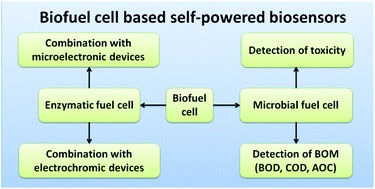
J. Mater. Chem. B, 2020,8, 3393-3407
https://doi.org/10.1039/C9TB02428J
Advances in functional nucleic acid based paper sensors
This article provides an extensive review of paper-based sensors that utilize functional nucleic acids, particularly DNA aptamers and DNAzymes, as recognition elements.
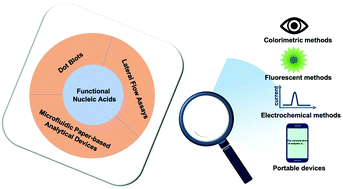
J. Mater. Chem. B, 2020,8, 3213-3230
https://doi.org/10.1039/C9TB02584G
Recent advances of tissue-interfaced chemical biosensors
This review discusses recent advances of tissue interfaced chemical biosensors, highlights current challenges and gives an outlook on future possibilities.
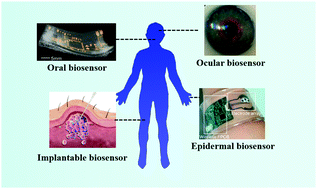
J. Mater. Chem. B, 2020,8, 3371-3381
https://doi.org/10.1039/C9TB02476J
Aggregation-induced emission luminogens for RONS sensing
The development of AIE bioprobes for RONS sensing in living systems is now summarized. We discuss some representative examples of AIEgen based bioprobes in terms of their molecular design, sensing mechanism and sensitive sensing in vitro and in vivo.
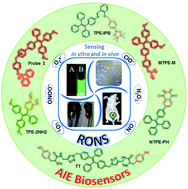
J. Mater. Chem. B, 2020,8, 3357-3370
https://doi.org/10.1039/C9TB02310K
An efficient strategy for circulating tumor cell detection: surface-enhanced Raman spectroscopy
Circulating tumor cells (CTCs) are circulating cancer cells that shed from tumor tissue into blood vessels and circulate in the blood to invade other organs, which results in fatal metastases. Surface-enhanced Raman scattering (SERS) has great potentials in CTCs detection.
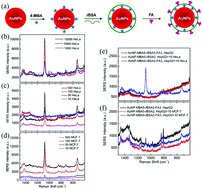
J. Mater. Chem. B, 2020,8, 3316-3326
https://doi.org/10.1039/C9TB02327E
Controlled/“living” radical polymerization-based signal amplification strategies for biosensing
Controlled/“living” radical polymerization-based signal amplification strategies and their applications in highly sensitive biosensing of clinically relevant biomolecules are reviewed.
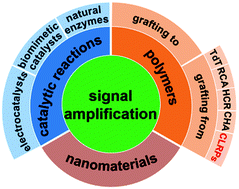
J. Mater. Chem. B, 2020,8, 3327-3340
https://doi.org/10.1039/C9TB02419K
Emerging intraoral biosensors
Intraoral biosensors are emerging as reliable medical devices for non-invasive health-care monitoring.
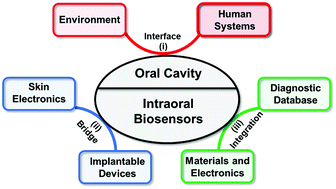
J. Mater. Chem. B, 2020,8, 3341-3356
https://doi.org/10.1039/C9TB02352F
Multi-emission metal–organic framework composites for multicomponent ratiometric fluorescence sensing: recent developments and future challenges
Ratiometric fluorescence sensors that are achieved via the ratiometric fluorescence intensity changes of emission peaks based on multi-emission fluorescence probes show a huge advantage.

J. Mater. Chem. B, 2020,8, 3292-3315
https://doi.org/10.1039/C9TB01931F
Biosensors and bioassays for determination of matrix metalloproteinases: state of the art and recent advances
This review highlights the recent advances in nanomaterial-based immunoassays for MMP abundance measurements and nanomaterial-based biosensors for MMP activity determination.
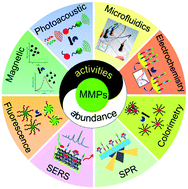
J. Mater. Chem. B, 2020,8, 3261-3291
https://doi.org/10.1039/C9TB02189B
Luminescence approaches for the rapid detection of disease-related receptor proteins using transition metal-based probes
Abnormally expressed receptor proteins are proved to be one of the crucial biomarkers for specific human diseases. Transitional metal based strategies possess delightful strengths in the in-field and real-time visualization of receptor proteins.
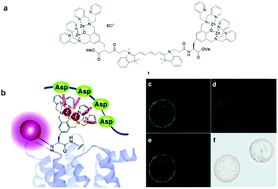
J. Mater. Chem. B, 2020,8, 3249-3260
https://doi.org/10.1039/C9TB01889A
Simulation-directed amplifiable nanoparticle enhanced quantitative scattering assay under low magnification dark field microscopy
A tunable linker-based signal amplification strategy yielding 6-fold enhanced sensitivity for low magnification dark-field quantitative assays.
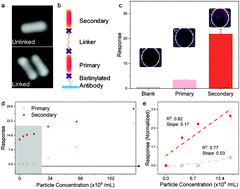
J. Mater. Chem. B, 2020,8, 5416-5419
https://doi.org/10.1039/D0TB00350F
Ti3C2Tx MXene-derived TiO2/C-QDs as oxidase mimics for the efficient diagnosis of glutathione in human serum
A Ti3C2Tx MXene-derived TiO2/C-QD oxidase mimic was developed and used for the efficient diagnosis of glutathione in human serum.
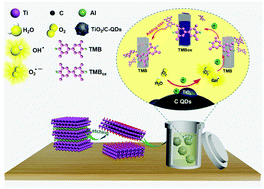
J. Mater. Chem. B, 2020,8, 3513-3518
https://doi.org/10.1039/C9TB02478F
A dual-targeted CeO2–DNA nanosensor for real-time imaging of H2O2 to assess atherosclerotic plaque vulnerability
A novel dual-targeted CeO2–DNA nanosensor by modifying with folic acid (FA) and CD36 antibody was designed.
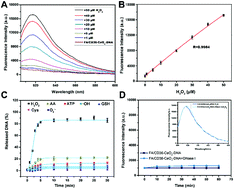
J. Mater. Chem. B, 2020,8, 3502-3505
https://doi.org/10.1039/C9TB02459J
Platinum ions mediate the interactions between DNA and carbon quantum dots: diagnosis of MRSA infections
The isothermal amplification products of mecA and femA genes induce the fluorescence quenching of platinum ions-capped carbon quantum dots to allow the specific identification of methicillin-resistant Staphylococcus aureus.
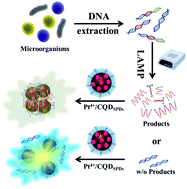
J. Mater. Chem. B, 2020,8, 3506-3512
https://doi.org/10.1039/C9TB02468A
Optical nanogap antennas as plasmonic biosensors for the detection of miRNA biomarkers
Gold nanogap antennas fabricated by hole-mask colloidal lithography as sensitive substrates for plasmonic biosensing.

J. Mater. Chem. B, 2020,8, 4310-4317
https://doi.org/10.1039/D0TB00307G
Toehold-regulated competitive assembly to accelerate the kinetics of graphene oxide-based biosensors
With toehold-regulation, the kinetics of graphene oxide-based biosensors can be accelerated.
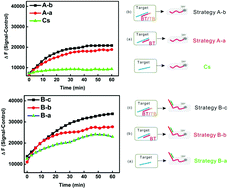
J. Mater. Chem. B, 2020,8, 3683-3689
https://doi.org/10.1039/C9TB02454A
A perylenetetracarboxylic dianhydride and aniline-assembled supramolecular nanomaterial with multi-color electrochemiluminescence for a highly sensitive label-free immunoassay
A novel multi-color ECL nanomaterial assembled from 3,4,9,10-perylenetetracarboxylic dianhydride (PTCDA) and aniline (An) was used for highly sensitive label-free CEA detection.
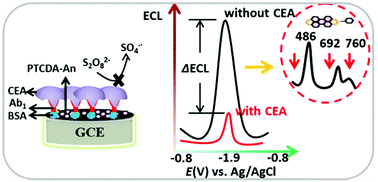
J. Mater. Chem. B, 2020,8, 3676-3682
https://doi.org/10.1039/C9TB02368B
Novel perylene probe-encapsulated metal–organic framework nanocomposites for ratiometric fluorescence detection of ATP
Schematic illustration of PDI@ZIF-8 nanocomposite synthesis and ratiometric fluorescence assay for ATP sensing. 2-MIm: 2-methylimidazole.
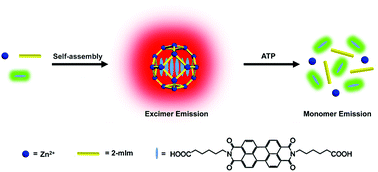
J. Mater. Chem. B, 2020,8, 3661-3666
https://doi.org/10.1039/C9TB02319D
Silver nanoprism-based plasmonic ELISA for sensitive detection of fluoroquinolones
Silver nanoprism-based plasmonic ELISA for qualitative and quantitative detection of fluoroquinolones.
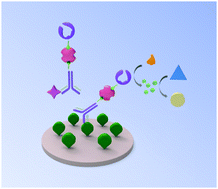
J. Mater. Chem. B, 2020,8, 3667-3675
https://doi.org/10.1039/C9TB02776A
Structurally coloured contact lens sensor for point-of-care ophthalmic health monitoring
A structurally coloured contact lens sensor has been developed for point-of-care diagnosis of eye diseases.
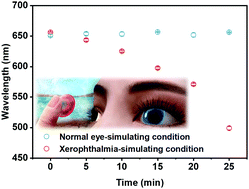
J. Mater. Chem. B, 2020,8, 3519-3526
https://doi.org/10.1039/C9TB02389E
Flexible and stretchable dual mode nanogenerator for rehabilitation monitoring and information interaction
Sensors with flexibility and stretchability are the key functional modules of converter between mechanical motions and electric signals for intelligent robots and rehabilitation training systems.
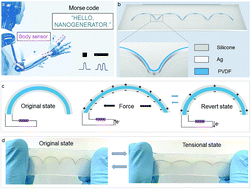
J. Mater. Chem. B, 2020,8, 3647-3654
https://doi.org/10.1039/C9TB02466B
Boosting biomolecular interactions through DNA origami nano-tailored biosensing interfaces
Nano-tailored DNA origami designs nanostructure the bioreceptor layer of encoded microparticles in an innovative microfluidic platform, hereby boosting biomolecular interactions.
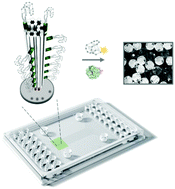
J. Mater. Chem. B, 2020,8, 3606-3615
https://doi.org/10.1039/C9TB02439E
Nucleoside-based fluorescent carbon dots for discrimination of metal ions
Using nucleosides and citrate as starting materials, a series of fluorescent carbon dots were synthesized showing different quenching properties by metal ions for their detection by a sensor array.

J. Mater. Chem. B, 2020,8, 3640-3646
https://doi.org/10.1039/C9TB02758K
Glutamate detection at the cellular level by means of polymer/enzyme multilayer modified carbon nanoelectrodes
Carbon nanoelectrodes in the sub-micron range were modified with an enzyme cascade immobilized in a spatially separated polymer double layer system for the detection of glutamate at the cellular level.
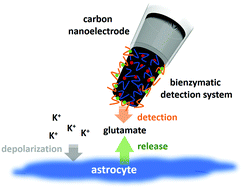
J. Mater. Chem. B, 2020,8, 3631-3639
https://doi.org/10.1039/C9TB02461A
Stretchable gold fiber-based wearable electrochemical sensor toward pH monitoring
A stretchable gold fiber-based wearable electrochemical pH two-electrodes sensing system for human health monitoring.
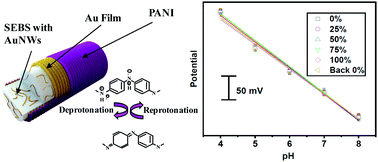
J. Mater. Chem. B, 2020,8, 3655-3660
https://doi.org/10.1039/C9TB02477H
Biomolecular detection, tracking, and manipulation using a magnetic nanoparticle-quantum dot platform
Fluorescent and magnetic materials play a significant role in biosensor technology, enabling sensitive quantification and separations with applications in diagnostics, purification, quality control, and therapeutics.
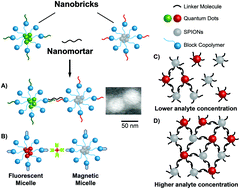
J. Mater. Chem. B, 2020,8, 3534-3541
https://doi.org/10.1039/C9TB02481F
Graphene–nucleic acid biointerface-engineered biosensors with tunable dynamic range
Programmed biosensors with tunable quantification range and higher specificity have been constructed by engineering graphene–nucleic acid biointerfaces.
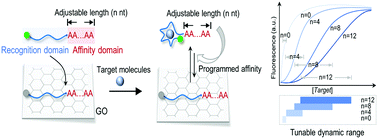
J. Mater. Chem. B, 2020,8, 3623-3630
https://doi.org/10.1039/C9TB02388G
Electrodeposition of nickel nanostructures using silica nanochannels as confinement for low-fouling enzyme-free glucose detection
This work reports an enzyme-free glucose sensor based on nickel nanostructures electrodeposited on a fluorine-doped tin oxide (FTO) electrode modified with a silica nanochannel membrane (SNM).
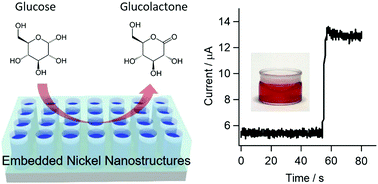
J. Mater. Chem. B, 2020,8, 3616-3622
https://doi.org/10.1039/C9TB02472G
Highly efficient electrochemiluminescence of ruthenium complex-functionalized CdS quantum dots and their analytical application
Highly efficient electrochemiluminescence of ruthenium complex-functionalized CdS quantum dots via ECL resonance energy transfer (ECL-RET) and their analytical application.
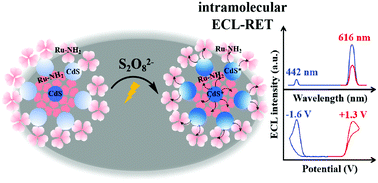
J. Mater. Chem. B, 2020,8, 3598-3605
https://doi.org/10.1039/C9TB02463H
A paper-based SERS assay for sensitive duplex cytokine detection towards the atherosclerosis-associated disease diagnosis
Novel SERS based sensing assay was built by combining nanoporous membrane with sandwich immunoassay for duplex cytokines detection. It can be used as a promising candidate for clinical application due to its excellent performance in human serum.
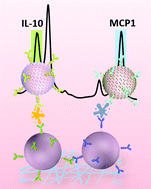
J. Mater. Chem. B, 2020,8, 3582-3589
https://doi.org/10.1039/C9TB02469G
Ultrasensitive self-enhanced electrochemiluminescence sensor based on novel PAN@Ru@PEI@Nafion nanofiber mat
A novel self-enhanced electrochemiluminescence nanofiber mat was for the first time prepared by one-step electrospinning a mixture of polyacrylonitrile, Ru(bpy)32+, poly(ethylenimine) and Nafion.
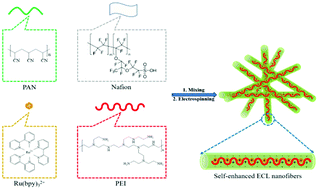
J. Mater. Chem. B, 2020,8, 3590-3597
https://doi.org/10.1039/C9TB02287B
A single-liquid miniature biofuel cell with boosting power density via gas diffusion bioelectrodes
A single-liquid glucose–O2 cell is constructed by gas diffusion electrode. O2 diffusion directly from air to active sites of enzyme enhances the enzymatic reaction rate. The maximum power output density of the cell is 53 μW cm−2.
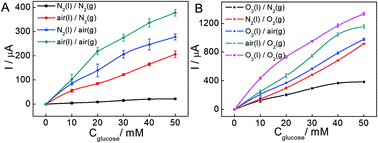
J. Mater. Chem. B, 2020,8, 3550-3556
https://doi.org/10.1039/C9TB02100K
Turn-on fluorescent glutathione detection based on lucigenin and MnO2 nanosheets
A GSH sensing platform using lucigenin as a fluorescent probe in the presence of MnO2 nanosheets was reported for the first time.
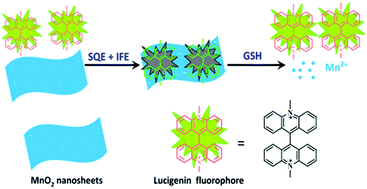
J. Mater. Chem. B, 2020,8, 3542-3549
https://doi.org/10.1039/C9TB02158B
Functionalized tungsten disulfide nanotubes for dopamine and catechol detection in a tyrosinase-based amperometric biosensor design
Functionalized tungsten disulfide nanotubes were evaluated as an enzyme support for electrochemical biosensors.

J. Mater. Chem. B, 2020,8, 3566-3573
https://doi.org/10.1039/C9TB01926J
A self-assembled RNA-triple helix hydrogel drug delivery system targeting triple-negative breast cancer
A novel RNA-triple-helix hydrogel for treatment of triple negative breast cancers (TNBCs) by incorporating RNA-triple-helix and siRNA duplexes of CXCR4 into the same RNA nanoparticles was developed, without the synthetic polycationic reagents.
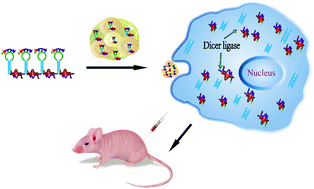
J. Mater. Chem. B, 2020,8, 3527-3533
https://doi.org/10.1039/C9TB01610D
A colorimetric and electrochemical dual-mode biosensor for thrombin using a magnetic separation technique
A colorimetric and electrochemical dual-mode biosensor for thrombin based on the combination of a magnetic separation technique and a signal amplification strategy.
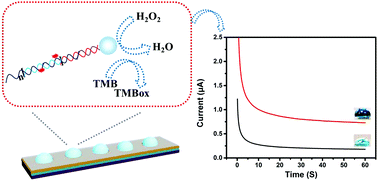
J. Mater. Chem. B, 2020,8, 3574-3581
https://doi.org/10.1039/C9TB02170A
Biotinylated and fluorophore-incorporated polymeric mixed micelles for tumor cell-specific turn-on fluorescence imaging of Al3+
We construct tumor-targeting fluorescent mixed nano-micelles for tumor cell-specific turn-on fluorescence imaging of Al3+.
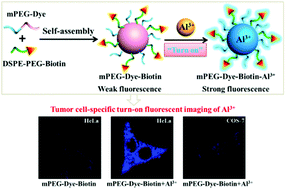
J. Mater. Chem. B, 2020,8, 3557-3565
https://doi.org/10.1039/C9TB01508F
About this collection
Guest edited by Shaoqin Liu (Harbin Institute of Technology) and Ning Gu (Southeast University).
In the last couple of decades, a broad range of materials, including organic small molecules, inorganic materials, hydrogels, hybrids, or emerging nanomaterials and structures, have been proposed for the biosensors, skin-like electronics, implantable electronics, medicine diagnosis and monitoring, and so on. These new materials results in numerous new methods and techniques. These technologies have shown great advantages over conventional assays, particularly in sensitivity, selectivity, and practicality.
This themed issue in Journal of Materials Chemistry B aims to explore the latest developments in the materials design and synthesis, novel design and function of biosensors and bioelectronics, and potential applications for healthcare and biomedicine diagnosis.